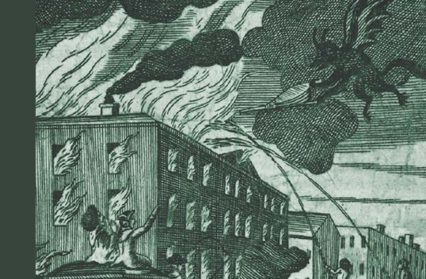Matt Jones reviews a new volume from University of Wales Press which promises to carve out a “new area of study” with its exploration of the industrial Gothic, Bridget M Marshall’s Industrial Gothic: Workers, Exploitation and Urbanization in Transatlantic Nineteenth-Century Literature.
Marshall opens this significant new book on the Industrial Gothic by positioning the Gothic genre within an historical context of both the Industrial Revolution and subsequent Industrial genre of writing on both sides of the Atlantic. Analysing a variety of forms, including poetry, short-and long-term fiction, nonfiction, and drama, Marshall seeks to emphasise the role of working-class workers, especially women, within the Industrial Revolution. Both the early Gothic and Gothic revival are successfully employed as a way of responding to the emerging Industrial landscape.
More than just introducing the Gothic as a response to the Industrial Revolution, Marshall considers the importance of the popularity of the Gothic genre amongst working class, as well as middle class readership of the nineteenth century. Using the cotton mill as an example of the Industrial Revolution’s impact on both Industrial workers and the surrounding landscape, Marshall argues the popularity of the Gothic genre is based upon its use of uncertainty, monsters, and pain and suffering. Such dark representations of the Victorian zeitgeist appealed to readers as a way of coping with the uncertainty and exploitation suffered by workers in a period of increasing Industrialisation.
Chapters one and two emphasise the similarities between both the Gothic and Industrial novel, allowing Marshall to delve into the popularity of the form. It was, Marshall contends, the Industrial novel itself that allowed the re-emergence of the popularity of the Gothic novel at the end of the nineteenth century. Whilst the novel is the most recognisable of the Gothic forms, Marshall persuasively argues in the second chapter for the importance of the factory girl within other forms. The popularity of the depictions of factory workers has its origins in the Gothic trope of the woman in distress. An Industrial genre applied this representation towards the anxiety surrounding factory girls who were often at risk from employers, doctors, and clergymen within the workplace. Marshall examines these incidents and traces how such images of the isolated female in distress were reworked into Industrial literature to capture the anxiety of an audience aware of the new employment opportunities afforded women in the Industrial workplace. Though I agree with Marshall’s analysis of the woman in distress as a response to anxiety surrounding the role of women in Victorian Britain, I would add the Industrial Revolution’s employment of women was not entirely negative. The employment of women created a momentum of support that would influence the acceptance of the first women into university, beginning with the London Nine at the University of London in June 1868.
The popularity of the trope of a woman in distress resurfaces in chapter three, where Marshall considers its use alongside other Gothic techniques that would be re-worked by Industrial novels. The depictions of imprisonment within both fiction and non-fiction writing are identified with the challenges of Industrial work together with the mill workers’ physical, mental, and emotional experiences. In addition to imprisonment, Marshall seizes the opportunity to explore the plight of mill workers, drawing parallels to the suffering of workers within the cotton industry of the Southern States of the USA. Exploitation was a common theme of Industrial workers within Industrial literature as suggested through the experiences of slavery still practiced in the USA in the leadup to the American Civil War. Here Marshall creates clear and interesting links between early Gothic settings of castles and monasteries and Industrial factory settings to emphasise the exploitative treatment of paid workers and slaves by the textile industry.
The links between slavery and exploitation as a consequence of the Industrial Revolution are considered further in chapter four. Marshall demonstrates how the Industrial Revolution creates monsters in its factory workers through Industrial accidents and its subsequent deformities which related to the Gothic’s use of monstrous characters such as Frankenstein’s monster. The sympathy and horror created by the Industrial genre created distrust within the public for the measures of progress and subsequent human casualties that the Industrial Revolution brought. Gothic monsters apply this methodology of fear towards factory owners and Industrialists as well as workers. These comparisons between monsters and Industrialisation are persuasive but can be further expanded through an examination of worker exploitation in the North of the USA. I am reminded of the satirical depiction of railroad tycoon and financier Jay Gould as a slave driver in Mark Twain’s Connecticut Yankee in King Arthur’s Court which suggests how worker exploitation was recognised in the Northern states of the US as well as the South.
Distrust and exploitation also led to a horror that resulted in growing anxiety of the Industrial Revolution’s impact on the environment. Marshall identifies how Industrialisation exploited the environment as well as the individual. An examination of both fiction and non-fiction texts that discuss Industrial settings and workers reveal how the devastation of the natural environment and a creation of new gloomier landscapes appealed to an anxious readership contemplating the potential for nature’s revenge. Marshall applies contemporary thoughts of the Anthropocene, concerning the potential for humans to threaten and impact the environment, into the Industrial Revolution. The Gothic genre’s use of uncertainty, Marshall argues, enabled writers to apply the concerns of change, devastation, and exploitation towards the destruction of the environment by the Industrial Revolution. Whilst I consider this treatment of humans destroying the environment as interesting, it also important to acknowledge the political context of the Industrial Revolution. Following extensive protests by workers, politicians, and factory owners themselves in the early 1830s limitations were imposed to reduce exploitation. For example, The Factory Act of 1833 sought to ensure that Industrial factories were inspected on a regular basis for mistreatment of workers. Overlooking these significant political developments risks oversimplifying the Industrial Revolution as a entirely negative development when in fact workers’ rights began their development at this turbulent time.
Overall, Marshall persuasively argues for the importance of the Industrial Revolution on the Gothic genre. Such Gothic tropes as uncertainty, the woman in distress, and monsters would fuel the anxieties surrounding the Industrial Revolution and its subsequent influence on the Industrial genre of literature. The Industrial Revolution brought uncertainty, monsters, and darkness to its inhabitants which found itself at home amongst readers of the time. Considering the current uncertainties we find ourselves grappling with, Marshall’s book offers new perspectives for approaching the challenges of contemporary workers’ experiences and horror within a post-Industrial landscape and an ongoing war in Ukraine. It requires little effort of the imagination to empathise with such darkness and uncertainty as we ourselves struggle to keep the lights on.
Bridget M Marshall’s Industrial Gothic: Workers, Exploitation and Urbanization in Transatlantic Nineteenth-Century Literature is available from University of Wales Press now.
Matt Jones is currently studying an MA in English Literature at Cardiff University after winning an Excellence Scholarship. He is particularly interested in the influence of European political radicalism on British Romantic writers.












